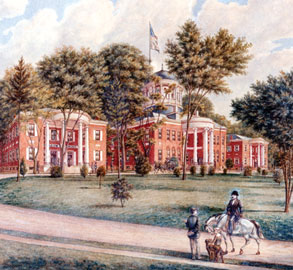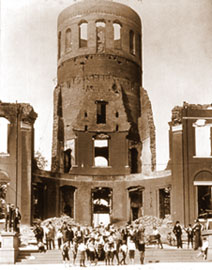Stephen HillsStephen Hills, a native of Ashford, Kent County, England, was born on August 10, 1771. As customary to a time when parents often had more children than money, at age 14 Hills was "bound out" to a local housewright as an indentured apprentice, alongside his older brother Richard. Under the instruction of his master, Hills received training in design and construction until age 21 when he was released. At age 23, Hills married Margaret Ashby and together in early 1794 they emigrated to the United States. Later that December, the couple celebrated the birth of a daughter, Sarah (joined over the next six years by sons John and Stephen junior). After settling in Boston, Hills labored as a housewright and later founded his own carpentry business. As his business grew, Hills sent word to his brother Richard who together with their younger brother William came to Boston to help. Around 1801 Hills followed a commission to Pennsylvania and settled in Lancaster, while his brother Richard took over his business in Boston. The move to Lancaster further enhanced his reputation with such commissions as a house for lawyer William Montgomery at 21 South Queen Street in 1803, followed by several others in the area. The following year Stephen and Margaret welcomed their third son, Thomas. The Legislature of Pennsylvania determined in February of 1810, during Governor Simon Snyder's term of office, to remove the seat of government from Lancaster to Harrisburg. The Assembly commissioned carpenters Bucher, Crouch and Dorsey, who employed Steven Hill for the work on remodeling the Dauphin County Court House for use as a temporary "Capitol." Hills also erected two buildings for the legislature to use when it moved to Harrisburg in October 1812. When Hill's received the commission for the legislative buildings he relocated his family from Lancaster to a home in Harrisburg that he built at 27 North Front Street. While remodeling the Dauphin County Courthouse and constructing the north and south Capitol executive buildings, he also designed and constructed many homes for prominent citizens of the city. One such home was for Commissioner Robert Harris, one of the men who supervised the legislative move of the capital seat to Harrisburg. Governor Snyder authorized proposals for a larger central or "main" Capitol on March 18, 1816. Two known drawings were submitted for what would be the initial design request for the first Capitol. The first was by the eminent William Strickland, and the second by James C. Lavelier — both calling for $300,000 for construction — an amount well above what the General Assembly had in its budget. On March 1816 the Assembly authorized the first of many appropriations for the acquisition of construction materials, and for two years Stephen Hills was paid for assembling materials to construct the new Capitol. At last in January 1819 the Assembly called for new proposals for the erection of a Capitol and advertisements were placed in newspapers. Of the seventeen proposals submitted, two were selected for final consideration. They were from Robert Mills who came in second and Stephen Hills who won first prize. The cornerstone was laid on May 31, 1819 and the Capitol was dedicated January 2, 1822. Stephen Hills went on to design Missouri's first state Capitol built from 1837-1840, along with Academic Hall, the first building for the University of Missouri. Sadly all three buildings were eventually destroyed by fire. After completing his University contract in the spring of 1843, Hills retired to his farm in western Illinois. He died there on October 17, 1844. |


